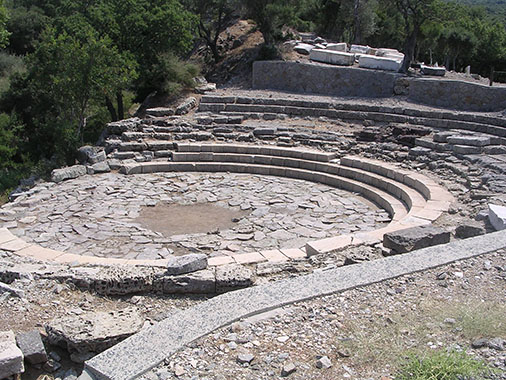|
|
 |
| My Favourite Planet > English > Europe > Greece > Northern Aegean > Samothraki > gallery |
 |
| Samothraki, Greece |
Samothraki gallery |
 |
 |
16 of 46 |
 |
 |
|
 |

The Theatral Circle (5th - 4th century BC) in the Sanctuary of the Great Gods, Samothraki. |
| |
The Theatral Circle (also referred to as the Sacred Circle), around 9 metres in diameter, is the oldest surviving permanent structure of the Sanctuary of the Great Gods [1]. It stands a terrace built on the eastern hill of the sanctuary, on the west bank of the deep gorge of the eastern stream, directly opposite the Propylon of Ptolemy II (see gallery page 18), the monumental entrance to the sanctuary.

The Theatral Circle complex was constructed in at least three phases of development. The surving elements which can now be seen at the sanctuary were built in the 5th - 4th century BC, when the circle was expanded. The photo above shows the circle as seen from the northwest.

According to recent theories the circle was a kind of sacred reception area: the space just within the entrance to the sanctuary where cult members and new intitiates arrived in a procession and took part in rituals before continuing along the Sacred Way to other stations within the sacred area.

After entering the sanctuary through the Propylon of Ptolemy II, an open stairway (perhaps originally a simple bridge) led across the stream to the terrace on which the circle stands. It is thought that the four tiers of steps around the circle were designed for standing rather than sitting, and that they could hold as many as 240 participants. Another step was added in the 4th century BC, allowing perhaps as many 335.

At the north of the circle, raised on a platform of polygonal masonry (bottom right in the photo above; see also photo on the next page), stood a pavilion which may have acted as a kind of reception centre. The older building which stood here has been named the "Fieldstone Building" by archaeologists.

The most recent building was an elegant marble Doric hexastyle prostyle (a roofed porch in front, supported by six Doric columns) temple-like structure. The facade was made of Pentelic marble, and the small chamber or stoa of Thasian marble. Surviving fragments of an inscription from the facade mention kings Philip and Alexander, from which it is thought that the building was dedicated by successors of Alexander the Great, his half-brother Philip III Arrhidaios and his posthumous son Alexander IV, who ruled together briefly 323-317 BC.

In the late third to early second century BC a smaller Ionic porch was added to the rear of the building.

At some point this building was destroyed, and rather than rebuild it, it appears that the decision was made to bury its parts, many of which have been unearthed in good condition by archaeologists.

Several statue bases have been discovered on the eastern hill, west of the circle, although it is uncertain whether they were directly connected with the Theatral Circle complex. However, following the construction of the building dedicated by Philip III and Alexander IV, several life-sized bronze statues were erected around the western edge of the circle. So far 22 marble statue bases without inscriptions have been discovered here. |
|
photo:
© David John |
|
| |
| Samothraki |
Notes, references and links |
 |
|

1. The Theatral Circle

See: Bonna D. Wescoat, Coming and going in the Sanctuary of the Great Gods, Samothrace. In: Bonna D. Wescoat and Robert G. Ousterhout (editors), Architecture of the sacred: Space, Ritual, and Experience from Classical Greece to Byzantium, Chapter 3 (pages 66-113). Cambridge University Press, 2012. |
|
|
Photos, maps and articles: © David John,
except where otherwise specified.
All photos and articles are copyright protected.
Images and materials by other authors
have been attributed where applicable.
Please do not use these photos or articles without permission.
If you are interested in using any of the photos for your website,
project or publication, please get in contact.
Higher resolution versions are available on request.
Some of the information and photos in this guide to Samothraki
originally appeared in 2004 on davidjohnberlin.de.
My Favourite Planet makes great efforts to provide comprehensive and accurate information across this website. However, we can take no responsibility for inaccuracies or changes made by providers of services mentioned on these pages. |
|
| |
 |
Visit the My Favourite Planet Group on Facebook.

Join the group, write a message or comment,
post photos and videos, start a discussion... |
|
|
 |
|
|
| |
| |
 |
| |
 |
| |
 |
| |
 |
| |

George Alvanos

rooms
in Kavala's historic Panagia District

Anthemiou 35,
Kavala, Greece

kavalarooms.gr
 |
| |
|